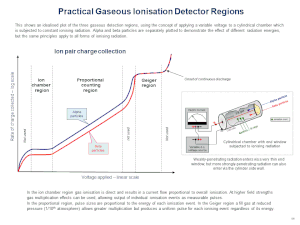
Gaseous ionization detectors are radiation detection instruments used in particle physics to detect the presence of ionizing particles, and in radiation protection applications to measure ionizing radiation.
They use the ionising effect of radiation upon a gas-filled sensor. If a particle has enough energy to ionize a gas atom or molecule, the resulting electrons and ions cause a current flow which can be measured.
Gaseous ionisation detectors form an important group of instruments used for radiation detection and measurement. This article gives a quick overview of the principal types, and more detailed information can be found in the articles on each instrument. The accompanying plot shows the variation of ion pair generation with varying applied voltage for constant incident radiation. There are three main practical operating regions, one of which each type utilises.